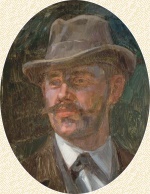|
Wilhelm Trübner was an important German painter of Realism. He belonged to the Leibl-circle of artists around Wilhelm Leibl, and joined the Munich and Berlin Secessions.
Born: 03 February 1851 in Heidelberg
Died: 21 December 1917 in Karlsruhe
Wilhelm Trübner enjoys a variety of artistic trainings. Molded by the activities of his father who was a goldsmith, the sixteen-year-old Trübner enrolls at the Karlsruhe school of art and travels to Munich a year later, where he attends the First International Art Exhibition in 1869. His teachers are the Stuttgart artist Hans Canon and Wilhelm von Diez in Munich. Trübner gets acquainted with the circle around Wilhelm Leibl in 1871. From this moment on, he is then closely connected with the artists around Leibl. They travel together and inspire each other. Trübner is the youngest artist in this circle, which includes Hans Thoma, Theodor Alt, Fritz Schider and Carl Schuch. His early work, which is characterized by its unique painterly splendor, consists of realistic landscapes. At the age of 24, Trübner is enlisted by the military. After a one-year training he has humanly and artistically changed, if not hardened and honed. His later work is characterized by artists of the Art Nouveau, with whom the painter practices artistic exchange in der 1890s, after the disintegration of the circle of Leibniz. During this time, he is a member of the Munich Secession with his unique large-format realistic paintings, including portraits and equestrian portraits, before being appointed professor at the academy in Karlsruhe and much later in Berlin.
|  |
|
|